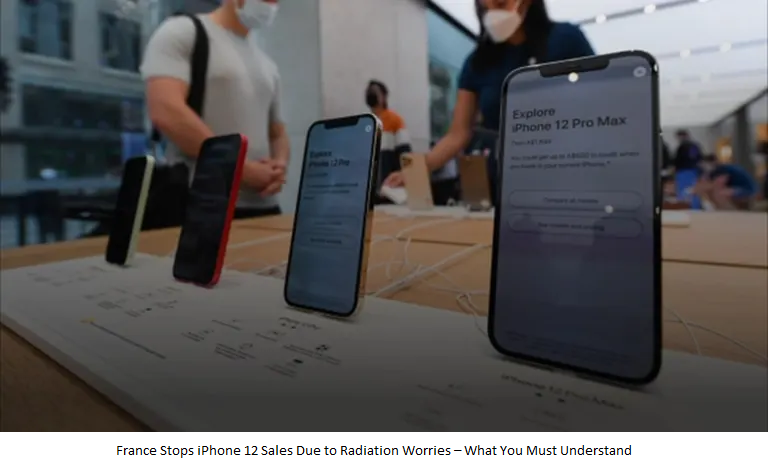France Stops iPhone 12 Sales Due to Radiation Worries – What You Must Understand

In a recent and unprecedented development, French regulators have taken a decisive step by demanding the removal of the iPhone 12 from the country’s market. This bold move has been fueled by mounting concerns regarding radiation exposure associated with the device. At the core of this controversy lies the Specific Absorption Rate (SAR), a critical metric used to measure the impact of electromagnetic waves on the human body. Shockingly, recent findings have unveiled that the iPhone 12 surpasses the legally permitted SAR limits, which has prompted French authorities to take swift and resolute action to protect public health and safety.
The ban on iPhone 12 sales in France has sent shockwaves through the tech industry and raised crucial questions about the implications of SAR levels in electronic devices. This article delves into the specifics of SAR, the reasons behind the ban, Apple’s response, and the broader implications on consumer electronics and public health.
Understanding SAR and Radiation Concerns
Specific Absorption Rate (SAR) stands as a pivotal metric employed to gauge the extent of the human body’s exposure to radio frequency (RF) energy emanating from an array of sources, cell phones being a prominent one. This metric serves as a crucial tool in assessing the safety quotient of electronic devices, particularly those we habitually carry around and hold close.
In France, regulatory authorities have meticulously defined a threshold for SAR, setting it at 4 watts per kilogram. This benchmark is carefully established to govern mobile phones, ensuring that they emit radio frequencies at levels deemed safe for users. The intention behind this regulation is to safeguard individuals from potential risks associated with prolonged or frequent exposure to elevated levels of RF energy. Notably, this limit is calibrated to account for the various ways users engage with their devices, including holding them to their ears during calls or stowing them away in pockets.
The iPhone 12 Dilemma: A SAR Reading Beyond Limits
The recent scrutiny on iPhone 12, undertaken by the National Frequency Agency of France (ANFR), brought to light a concerning revelation. According to their comprehensive tests, the iPhone 12 displayed a SAR reading of 5.74 watts per kilogram. This reading, surpassing the established limit of 4 watts per kilogram, promptly raised alarm bells within regulatory circles. It underscored a potential deviation from the prescribed safety levels, necessitating a reevaluation of the device’s compliance with established standards.
This finding effectively prompted the subsequent regulatory action of demanding the removal of iPhone 12 from the French market. The decision rested on the critical premise of prioritizing user safety and ensuring that electronic devices, despite their undeniable utility, do not pose unforeseen health risks. This incident not only serves as a cautionary tale but also accentuates the importance of rigorous assessments and adherence to SAR limits in preserving public health. It exemplifies the unwavering commitment of regulatory bodies to uphold safety protocols, even in the face of technological advancement and widespread device usage.
SAR is a metric used to measure the body’s exposure to radio frequency energy from various sources, including cell phones. In France, regulators have set a limit of 4 watts per kilogram for the SAR of phones that users may hold or keep in their pockets. However, tests conducted by the National Frequency Agency of France (ANFR) revealed that the iPhone 12 recorded a SAR of 5.74 watts per kilogram.
Apple’s Response and Global Standards
In response to the concerns raised, Apple stated that specific models of iPhone 12 designed for the United States, Canada, Japan, China’s mainland, Hong Kong, and Macao met the applicable limits. However, there was no mention of the iPhone 12 model A2407, which would be available in other countries and regions, such as Europe. Apple asserted that its iPhone 12 adheres to global radiation standards, although Forbes has reached out to Apple for further comments.
Broader Context on Electromagnetic Waves and Health Concerns
While the World Health Organization asserts that there are no immediate health concerns associated with low levels of electromagnetic waves, further research is still warranted. Studies, including one from the European Union, have suggested a potential link between extremely low-frequency electromagnetic fields and cancer, particularly in children exposed to power lines. However, it’s important to note that mobile phone use itself was not found to increase cancer risk.
Striking a Balance Between Innovation and Safety
The ban on iPhone 12 sales in France serves as a stark reminder of the critical need to monitor and regulate radiation exposure stemming from our most cherished electronic devices. In an era where technology is evolving at an unprecedented pace, it becomes imperative to weigh the benefits of innovation against potential health risks. This incident, occurring concurrently with the launch of the iPhone 15, thrust the dialogue surrounding electronic device safety into the spotlight.
As we move forward, it is essential for both manufacturers and regulatory bodies to collaborate closely. This collaboration should aim at setting and enforcing strict safety standards, ensuring that consumers can enjoy the fruits of technological progress without compromising their health. Striking this balance is not only a matter of policy and regulation but a shared responsibility to safeguard the well-being of individuals worldwide.
The ban in France resonates globally, emphasizing the pressing need for comprehensive assessments of device safety standards, and igniting a broader conversation about the implications of rapid technological advancements on public health.















